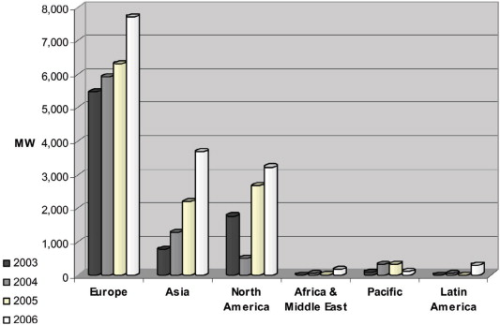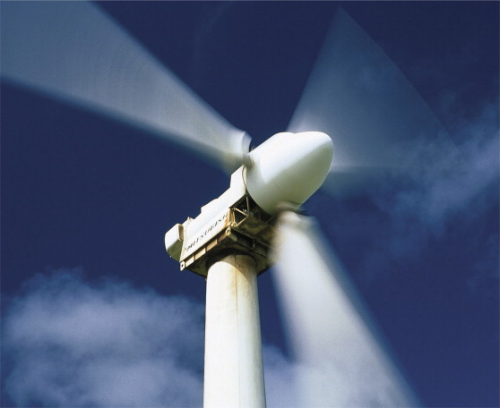

The global wind energy market experienced yet another record year in 2006, demonstrating a growth of 32% over 2005 figures. According to the latest statistics issued by the Global Wind Energy Council (GWEC) 2006 saw the installation of 15 197 megawatts (MW) of new capacity, taking total installed wind energy capacity to 74 223 MW.
In terms of economic value, the wind energy sector is now established as an important player in the energy market, the GWEC says. The total value of new generating equipment installed in 2006 was worth €18 billion (US$23 billion).
The countries with the highest total installed capacity are Germany (20 621 MW), Spain (11 615 MW), the USA (11 603 MW), India (6270 MW) and Denmark (3136 MW). Thirteen countries around the world have now passed 1000 MW level for installed capacity.
In terms of new capacity added in 2006, the USA led the way with 2454 MW, followed by Germany (2233 MW), India (1840 MW), Spain (1587 MW), China (1347 MW) and France (810 MW). These figures show that new players such as China and France are gaining ground.
Europe
Europe is still the leading player in the market, with 48 545 MW of installed capacity at the end of 2006 – 65% of the global total. In 2006, European wind capacity grew by 19%, producing approximately 100 TWh of electricity, equal to 3.3% of total European Union (EU) electricity consumption in an average wind year.
“While Germany and Spain still represent 50% of the EU market, we are seeing a healthy trend towards less reliance on these two countries," says Christian Kjaer, the European Wind Energy Association's (EWEA) CEO. "In the EU, 3755 MW were installed outside of Germany, Spain and Denmark in 2006. In 2002, this figure still stood at only 680 MW. The figures clearly confirm that a second wave of European countries is investing in wind power.”
Despite the continuing growth in Europe, other regions are starting to catch up. The growth in the European market in 2006 accounted for about 50% of the total new capacity, down from nearly 75% in 2004.
Asia
Asia experienced the strongest increase in installed capacity outside of Europe, with an addition of 3679 MW. This takes the continent's total to over 10 600 MW.
In 2006, wind capacity in Asia grew by 53% and accounted for 24% of new installations. The strongest market remains India, which installed over 1840 MW of new capacity in 2006, increasing its total to 6270 MW.
China more than doubled its total installed capacity in 2006, taking it up to 2604 MW by installing 1347 MW of capacity, making it the sixth largest market worldwide. The Chinese market was boosted by the country's new Renewable Energy Law, which entered into force on 1 January 2006.
“Thanks to the Renewable Energy Law, the Chinese market has grown substantially in 2006, and this growth is expected to continue and speed up,” says Li Junfeng of the Chinese Renewable Energy Industry Association (CREIA). “According to the list of approved projects and those under construction, more than 1500 MW will be installed in 2007. The goal for wind power in China by the end of 2010 is 5000 MW, which according to our estimations will be reached well ahead of time.”
North America
North America accounted for 22% of the world's new installed wind capacity in 2006. For the second year running, the US wind energy industry installed nearly 2500 MW, making it the country with the most new wind power.
“Wind's exponential growth reflects the nation's increasing demand for clean, safe and domestic energy, and continues to attract both private and public sources of capital,” comments Randy Swisher, president of the American Wind Energy Association (AWEA). “New generating capacity worth US$4 billion was installed in 2006, billing wind as one of the largest sources of new power generation in the country – second only to natural gas – for the second year in a row.”
Canada also had a record year, with the installed capacity more than doubling from 683 MW in 2005 to 1459 MW at the end of 2006.
“Wind energy is an emerging Canadian success story and 2006 will be remembered as the year that our country first began to seriously capture its economic and environmental benefits,” according to Robert Hornung, president of the Canadian Wind Energy Association (CanWEA). “Canada's on the cusp of a wind energy boom as provincial governments are now targeting to have a minimum of 10 000 MW of installed wind energy capacity in place by 2015.”
| New capacity | MW | Market share (%) |
| USA | 2452 | 16.1 |
| Germany | 2233 | 14.7 |
| India | 1840 | 12.1 |
| Spain | 1587 | 10.4 |
| China | 1347 | 8.9 |
| France | 810 | 5.3 |
| Canada | 776 | 5.1 |
| Portugal | 694 | 4.6 |
| UK | 634 | 4.2 |
| Italy | 417 | 2.7 |
| Total 10 total | 12,792 | 84.2 |
| Rest of world | 2405 | 15.8 |
| World total | 15,197 |
Rest of world
Growth in the relatively young African and Middle Eastern market picked up considerably in 2006, with 172 MW of new installed capacity, bringing the total up to 441 MW. This represents a 63% growth. The main countries experiencing increases are Egypt, Morocco and Iran.
Compared to previous years, the Australian market only experienced slow growth in 2006.
“While 2006 saw only 109 MW installed bring total capacity to 817 MW, the Australian market has been given a new lease of life with the introduction of state based renewable energy targets providing a more positive outlook for 2007,” says Dominique La Fontaine, CEO of the Australian Wind Energy Association (Auswind).
Mainstream
“As security of energy supply and climate change are ranging high on the political agendas of the world's governments, wind energy has already become a mainstream energy source in many countries around the world," says Arthouros Zervos, Chairman of GWEC. "Wind energy is clean and fuel-free, which makes it the most attractive solution to the world's energy challenges.”
“The tremendous growth in 2006 shows that decision makers are starting to take seriously the benefits that wind energy development can bring. However, we must not forget that wind energy is a new technology that needs robust policy frameworks and political commitment to fulfill its full potential,” he warns.



